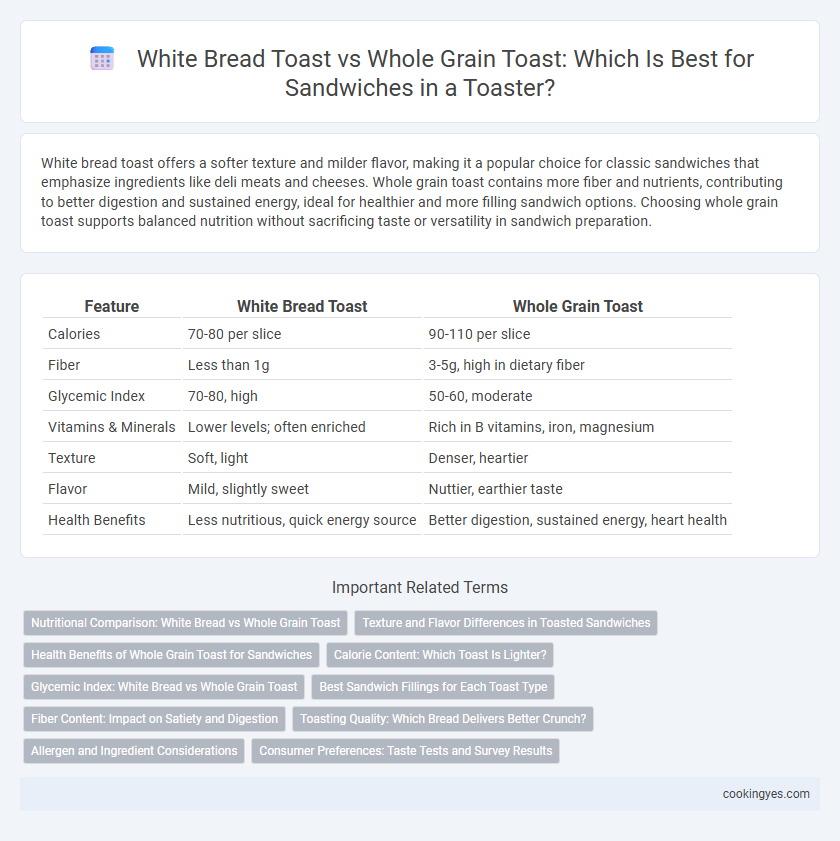White bread toast offers a softer texture and milder flavor, making it a popular choice for classic sandwiches that emphasize ingredients like deli meats and cheeses. Whole grain toast contains more fiber and nutrients, contributing to better digestion and sustained energy, ideal for healthier and more filling sandwich options. Choosing whole grain toast supports balanced nutrition without sacrificing taste or versatility in sandwich preparation.
Table of Comparison
| Feature | White Bread Toast | Whole Grain Toast |
|---|---|---|
| Calories | 70-80 per slice | 90-110 per slice |
| Fiber | Less than 1g | 3-5g, high in dietary fiber |
| Glycemic Index | 70-80, high | 50-60, moderate |
| Vitamins & Minerals | Lower levels; often enriched | Rich in B vitamins, iron, magnesium |
| Texture | Soft, light | Denser, heartier |
| Flavor | Mild, slightly sweet | Nuttier, earthier taste |
| Health Benefits | Less nutritious, quick energy source | Better digestion, sustained energy, heart health |
Nutritional Comparison: White Bread vs Whole Grain Toast
Whole grain toast offers higher fiber content, essential vitamins, and minerals compared to white bread toast, which is often stripped of these nutrients during processing. The complex carbohydrates in whole grain toast provide sustained energy and promote better digestive health, unlike the simple carbs found in white bread that can cause rapid blood sugar spikes. Choosing whole grain toast for sandwiches supports improved heart health and weight management due to its lower glycemic index and richer nutrient profile.
Texture and Flavor Differences in Toasted Sandwiches
White bread toast offers a soft, airy texture with a mild, slightly sweet flavor that enhances delicate sandwich fillings. Whole grain toast provides a denser, chewier bite and a robust, nutty taste that complements hearty ingredients. The texture and flavor differences significantly impact the overall sandwich experience, with white bread delivering lightness and whole grain adding depth.
Health Benefits of Whole Grain Toast for Sandwiches
Whole grain toast offers superior health benefits compared to white bread toast due to its higher fiber content, essential vitamins, and minerals such as magnesium and B vitamins. Consuming whole grain toast helps improve digestion, supports heart health, and aids in blood sugar regulation. The complex carbohydrates in whole grains provide sustained energy, making it an ideal base for nutritious sandwiches.
Calorie Content: Which Toast Is Lighter?
White bread toast typically contains fewer calories per slice, averaging around 70-80 calories, compared to whole grain toast which ranges from 90-110 calories due to its higher fiber and nutrient content. The increased caloric density in whole grain toast is attributed to intact grains and additional bran layers, providing more sustained energy but slightly increasing calorie count. For those prioritizing a lighter option based strictly on calorie content, white bread toast is generally the lower-calorie choice for sandwiches.
Glycemic Index: White Bread vs Whole Grain Toast
Whole grain toast has a significantly lower glycemic index (GI) compared to white bread toast, leading to slower glucose absorption and improved blood sugar control. White bread typically has a GI of around 70-75, while whole grain bread ranges between 50-65, making whole grain a healthier choice for managing insulin response. Choosing whole grain toast for sandwiches supports sustained energy levels and reduces the risk of insulin spikes.
Best Sandwich Fillings for Each Toast Type
White bread toast pairs well with classic sandwich fillings like ham, turkey, and mild cheeses, as its soft texture complements delicate flavors without overpowering them. Whole grain toast, rich in fiber and nutrients, enhances robust fillings such as roasted vegetables, avocado, smoked salmon, and sharp cheddar, providing a hearty base that balances stronger tastes. Choosing the right toast type maximizes both taste and nutritional value, aligning sandwich components with bread characteristics for optimal flavor harmony.
Fiber Content: Impact on Satiety and Digestion
Whole grain toast contains significantly higher fiber content than white bread toast, promoting better digestion and prolonged satiety after consumption. The dietary fiber in whole grain toast supports healthy bowel movements and a lower glycemic response, making it beneficial for weight management. White bread toast, with its refined flour, lacks sufficient fiber, often leading to quicker digestion and reduced feelings of fullness.
Toasting Quality: Which Bread Delivers Better Crunch?
White bread toast offers a lighter, airier crunch due to its fine crumb and higher moisture content, resulting in a crisp exterior and soft center ideal for mild sandwich fillings. Whole grain toast provides a denser, heartier crunch with a robust texture from intact bran and germ, enhancing flavor complexity and nutritional value. The choice between white and whole grain bread for toast hinges on desired crunch intensity and texture, with white bread delivering a delicate crispness and whole grain offering substantial bite and chew.
Allergen and Ingredient Considerations
White bread toast contains refined flour and may include allergens like gluten, soy, and dairy, posing risks for people with celiac disease, soy allergies, or lactose intolerance. Whole grain toast offers higher fiber and nutrient content but also contains gluten and may include nuts or seeds, requiring careful label review for those with specific allergies. Both types of toast necessitate checking ingredient lists to avoid allergic reactions and accommodate dietary restrictions in sandwich preparation.
Consumer Preferences: Taste Tests and Survey Results
Consumer preferences for white bread toast versus whole grain toast in sandwiches reveal distinct taste test outcomes and survey data. White bread toast frequently scores higher for its soft texture and mild flavor, making it a preferred choice among those favoring traditional sandwich profiles. Whole grain toast attracts health-conscious consumers, offering a nuttier taste and denser texture, which correlates with positive feedback in surveys emphasizing nutritional benefits.
White bread toast vs whole grain toast for sandwiches Infographic

 cookingyes.com
cookingyes.com